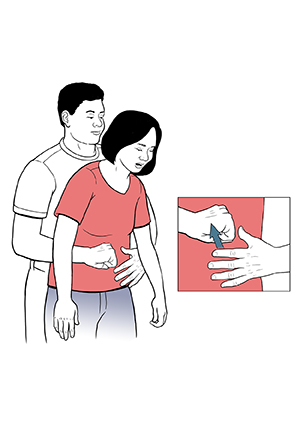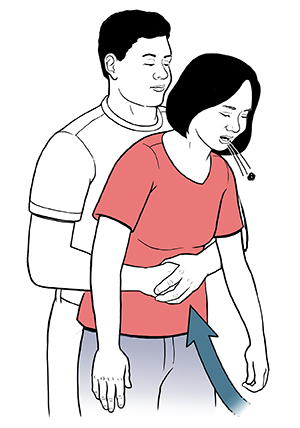When a Teen or Adult Is Choking
When a Teen or Adult Is Choking
Choking happens when a foreign object becomes stuck in your throat or windpipe, blocking the flow of air. This may be caused by a piece of food or a large pill. A complete blockage of your throat or windpipe stops air from going to your lungs. If this lasts long enough, the oxygen level in your blood goes down and causes you to lose consciousness.
Prevention
To prevent choking, do the following:
Cut food into small pieces.
Chew food slowly and thoroughly, especially if wearing dentures.
Don't laugh or talk while chewing or swallowing.
Don't drink a lot of alcohol before and during meals.
If you have difficulty swallowing large pills, it may be possible to crush them, or to get the liquid form if available. But some pills should not be crushed. Ask your pharmacist before crushing any of your medicines. You could also ask your healthcare provider to prescribe another type of medicine in a smaller size.
What to do
If you have a blockage that’s stopping air flow, you naturally want to grab your throat with both hands. That is the universal sign for choking. If someone appears to be choking and doesn't give this signal, look for these signs:
Can't speak
Difficulty breathing or noisy breathing
Can't cough forcefully
Skin, lips, and nails turning blue or dusky
Loss of consciousness
If you see any of the above signs, call 911 right away and take first aid measures if you are trained to do them. If you or your family doesn’t know how to give first aid for choking, call your local health department or community center for class information. It could be life-saving.
At the first sign of choking
If you are alone
If a victim is choking
Step 1. Identify choking
Ask the victim if he or she is choking. If the person cannot speak, say that you will help.
Don't slap the victim on the back. This may force the object lower into the airway.
Look for a hand raised to the throat, an instinctive response to choking.
Step 1 |
Step 2 |
Step 3 |
|---|
Step 2. Grasp from behind
Move behind the victim. Slide your palms under his or her arms, bringing your hands together in front of the victim's body.
Make a fist with one hand, placing the flat surface of the thumb and first finger above the belt line.
Note: If pregnancy or extreme overweight makes this impossible, give thrusts inward against the middle of the victim's breastbone.
Step 3. Thrust in and up
Cover your fist with the other hand, keeping your elbows away from your body.
Pull in and up quickly, using hard thrusts to force air from the victim's lungs. This pops out the blockage.
Repeat thrusts until the victim coughs or speaks.
When to call 911
Call 911 if any of these occur:
A choking spell that doesn't end right away
Loss of consciousness
Shortness of breath or noisy breathing
Skin, lips, and nails turning blue or dusky
Can't speak
Can't cough forcefully
For more information
The following organizations have information on first-aid classes near you:
American Heart Association www.heart.org/HEARTORG/
Red Cross Training and Certification www.redcross.org/ux/take-a-class
Updated:
June 07, 2018
Sources:
Berg, RA. Part 5: Adult Basic Life Support: 2010 American Heart Association Guidelines for Cardiopulmonary Resuscitation and Emergency Cardiovascular care. Circulation, 2010, 122; S685-S705., First Aid, CPR, and AED Advanced, ACEP, AAOS
Reviewed By:
Fraser, Marianne, MSN, RN,Perez, Eric, MD



